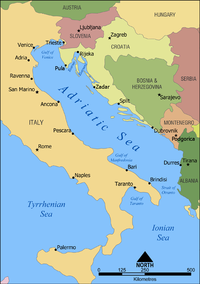
Photo from wikipedia
Abstract Benthic ostracods and foraminifers are commonly applied as paleoenvironmental indicators in shallow marine successions, ignoring that individual meiofaunal groups could provide distinct information. We aim to shed light on… Click to show full abstract
Abstract Benthic ostracods and foraminifers are commonly applied as paleoenvironmental indicators in shallow marine successions, ignoring that individual meiofaunal groups could provide distinct information. We aim to shed light on the distinct paleoecological record of benthic ostracods and foraminifers by analyzing the shallow marine Holocene succession of the Po Delta (Italy) in a sequence stratigraphic fashion. Multivariate elaborations connecting the modern North Adriatic reference set to fossil data allowed to investigate community dynamics, obtain quantitative estimates of (paleo-)environmental drivers and assess the meiofaunal response to coastal and delta dynamics through time and space under the influence of allogenic and autogenic factors. Benthic ostracods and foraminifers easily discern transgressive (TST) and highstand (HST) systems tract, and also discriminate between locations at different distance from paleo-river mouths under highstand conditions. Specifically, community changes reflecting shifts in delta regimes at distal locations suggest that lobe-fringe deposits are more indicated for paleoenvironmental purposes. We emphasize that a deep knowledge of the analyzed datasets should drive the interpretation of multivariate outputs, as reconstructed values from significantly similar deposits could be inappropriate, and the lack of true modern analogs could reflect authentic differences in community composition, or either pitfalls in the modern reference set. Our results show that ostracods evidence depositional regimes determined by the interplay of sediment supply and hydrodynamic energy in relationship with the position from main river outlets; on the other hand, foraminifers highlight changes in riverine inputs in terms of organic matter. Our findings demonstrate that shallow marine benthic ostracods and foraminifers provide distinct but complementary paleoecological information, and their integration allows to achieve high-resolution reconstructions.
Journal Title: Palaeogeography, Palaeoclimatology, Palaeoecology
Year Published: 2021
Link to full text (if available)
Share on Social Media: Sign Up to like & get
recommendations!